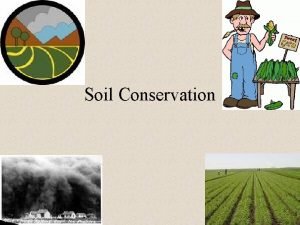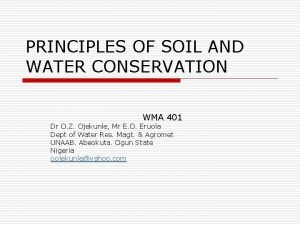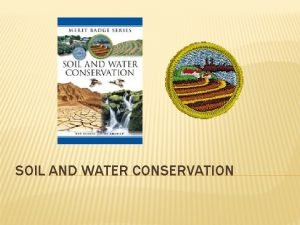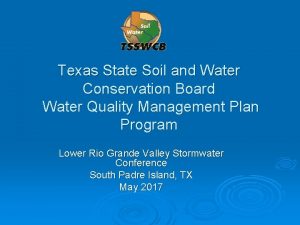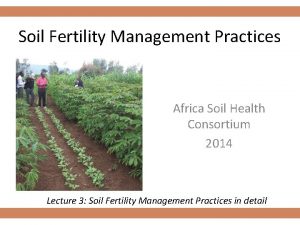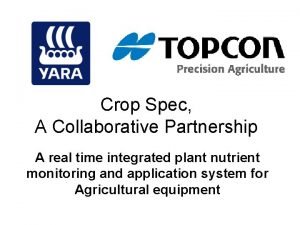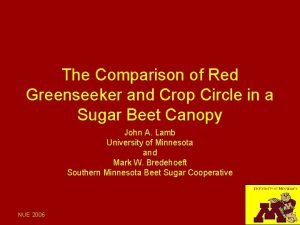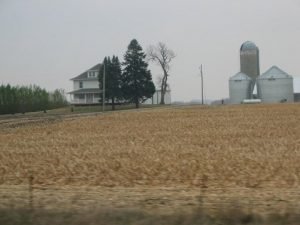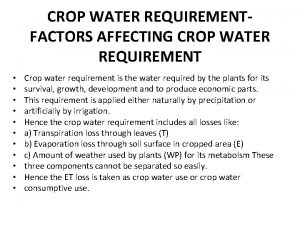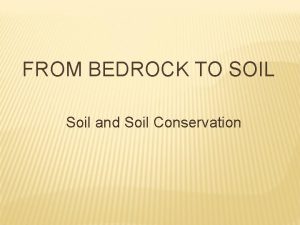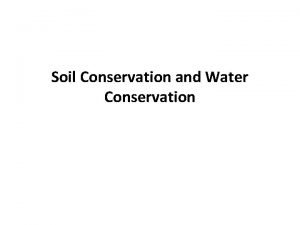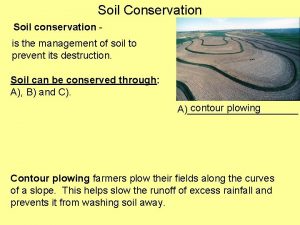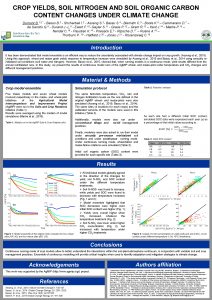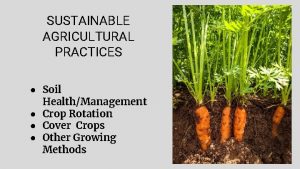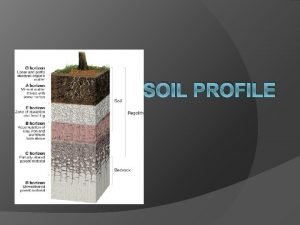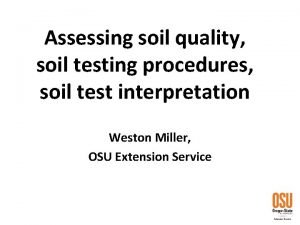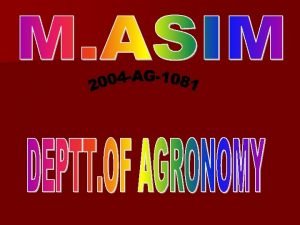Soil conservation practices Contents Soil conservation practices Crop






















- Slides: 22


Soil conservation practices

Contents Soil conservation practices Crop rotation Wind break Cover crop and mulching Conservation tillage Residue management Grassed waterways Buffer strips Diversion terraces Erosion prevention

Soil conservation practices n What is soil conservation? Soil conservation is a set of management strategies for prevention of soil being eroded from the Earth’s surface or becoming chemically altered by overuse, acidification, salinization or other chemical soil contamination. It is a component of environmental soil science.

Crop rotation n Is a tool that enable farmer to increase soil organic content, soil structures, and rooting depth n Accomplished by growing secondary crops which enhance soil health n Root crops are destructive to soil structure because of shattering of soil aggregates n So root crops should not grown more than once every three years

Cont…. n Recommended rotation for root crops n Year 1 -root crop n 2 nd year-grain crop n 3 rd year-forage

Windbreaks are created by planting sufficiently dense rows or stands of trees at the windward exposure of an agricultural field subject to wind erosion. Evergreen species are preferred to achieve year-round protection; however, as long as foliage is present in the seasons of bare soil surfaces, the effect of deciduous trees may also be adequate

Cover cropping and mulching n n n effective at reducing soil erosion by leaving a cover the soil which reduces soil displacement associated with the impact of raindrops hitting soil particles. They also reduce the volume and velocity of runoff over the soil.

Cover cropping and mulching

Cont…. n n n n Selecting the correct cover crop depends on: • How much cover will the crop supply • Can the crop be harvested the next season • The importance of weed control • Soil improvement • Nutrient conservation • Date of seeding

Mulching n n n Mulching consists of applying organic material over the exposed soil. Hay makes the best mulch, but it is important to ensure that the hay is harvested before weeds are mature. Straw can also be used. Mulch should be applied at a rate of 3. 3 to 4. 5 T/ha to ensure at least 85% cover of the soil surface.

Mulching

Conservation Tillage is field operation n aimed at preserving soil aggregates, organic n matter and surface residue from previous crop n n n n Conservation tillage can include changes such as: • timing of tillage (fall to spring) • using less destructive tillage implements (chise plough instead of moldboard plough) • less tillage (one pass instead of two)

Residue management n Residue management is a facet of n conservation tillage that is designed to leave n crop residue on the soil surface to prevent n erosion. The amount of residue on the soil

Residue management

Grassed waterways n n n n Grassed waterways are shallow channels that allow large volumes of runoff to flow down a slope without causing erosion. Grassed waterways can be constructed in natural depressions in fields where water accumulates. Waterways should be 6 m wide, 30 cm deep and have a saucer shape.

Grassed waterways

Buffer strips n n n n Buffer strips are vegetative areas that separate field boundaries from watercourses. These buffer strips are effective at stabilizing stream banks with their extensive root system. A proper buffer strip should consist of at least 3 m of natural vegetation and, if the field is row cropped, an additional 2 m wide grassed buffer strip should be left

Buffer strips

Diversion terraces n n n n Diversion terraces are shallow grassed ditches, with a berm on the downhill side, which are constructed across the slope to intercept surface runoff water moving down the field. Terrace construction information: Terraces may remove up to 5% of land from production Terraces should be designed to have a grade along the length that is less than 2% The position of a terrace in a field depends on field slope, soil type and other soil conservation practices used.


 Chapter 15 section 1 a new deal fights the depression
Chapter 15 section 1 a new deal fights the depression Soil conservation
Soil conservation Objectives of water conservation
Objectives of water conservation Explain water pollution
Explain water pollution Soil conservation and domestic allotment act
Soil conservation and domestic allotment act Hudson essex passaic soil conservation district
Hudson essex passaic soil conservation district Texas soil and water conservation board
Texas soil and water conservation board Soil conservation and domestic allotment act
Soil conservation and domestic allotment act Africa soil health consortium
Africa soil health consortium Living soil vs dead soil
Living soil vs dead soil What are the four spheres of the earth
What are the four spheres of the earth Contingent crop planning slideshare
Contingent crop planning slideshare Crop lien system
Crop lien system Flow polar com start
Flow polar com start Crop spec
Crop spec Crop rotation
Crop rotation Crop rotation
Crop rotation Bio science
Bio science Pigeon dissection labeled
Pigeon dissection labeled Tractor definition
Tractor definition Growth stages of rice
Growth stages of rice Trellis crop
Trellis crop Crop circle ndvi
Crop circle ndvi

